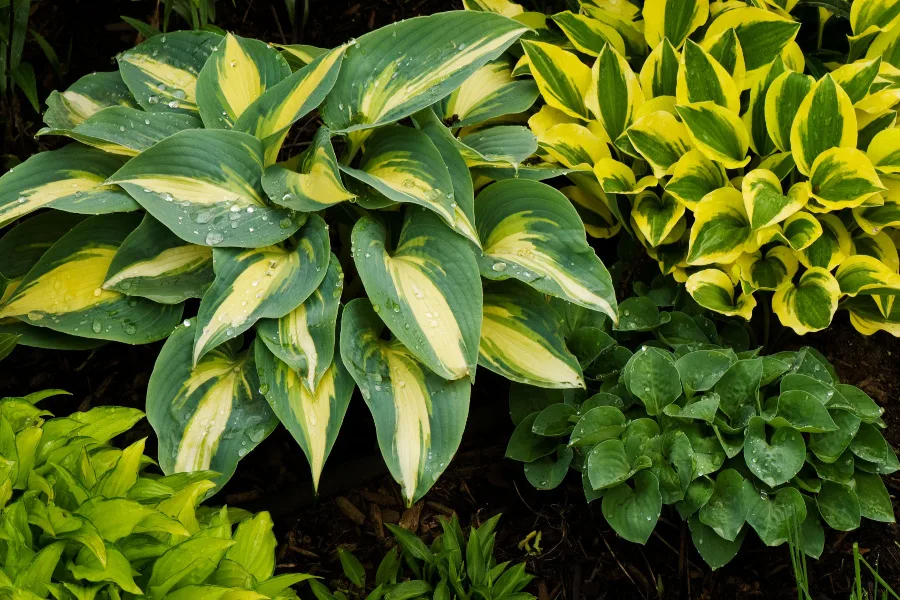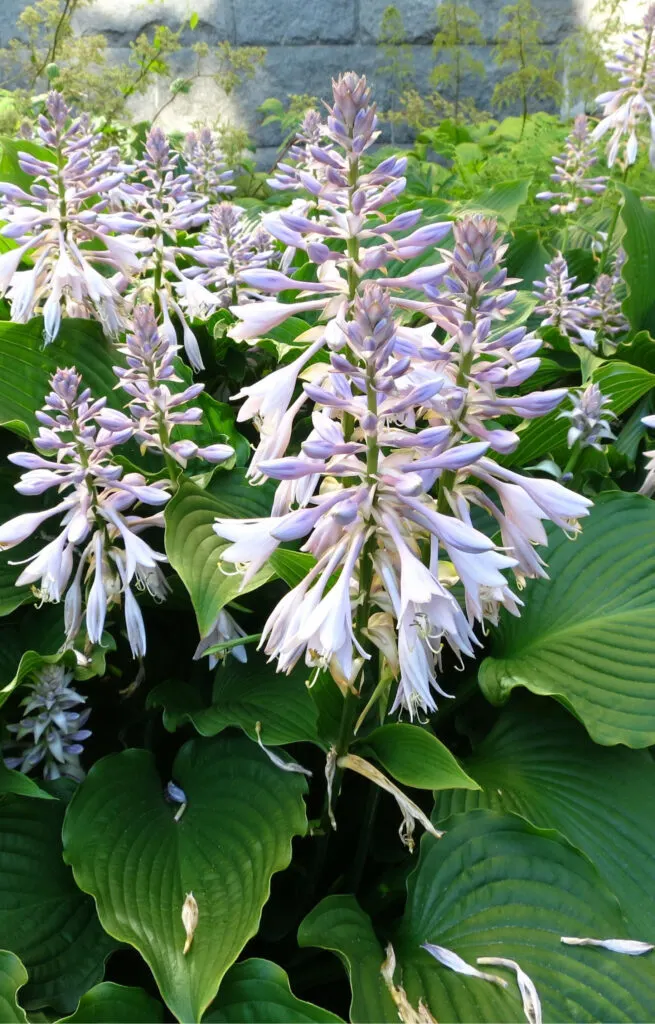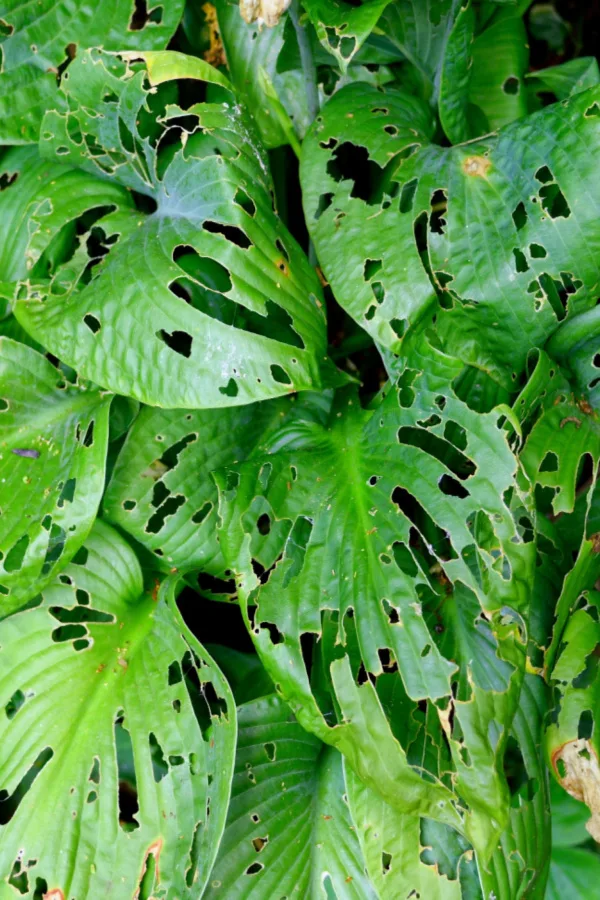Is it really possible to keep your hosta plants looking strong, healthy and beautiful – even through the long, hot summer months? You bet it is!
Hostas are one of the most popular shade-loving plants of all. Their lush, thick foliage can fill a flowerbed with loads of color and texture. From a near endless array of solid and variegated leaf patterns in green, white and even deep blue, they can be quite the sight to behold – especially in the spring when they first burst through the ground.
But unfortunately, for many gardeners, as the growing season progresses, their hosta plants begin to show serious signs of wear and tear. What was once a beautiful mass of foliage often becomes an ugly decaying clump of yellowing leaves by late July or early August.

The good news is that with just a bit of extra care, it really is possible to keep your hosta plants gorgeous. With that in mind, here is a look at three of the biggest secrets to keep your hostas looking good – from early spring – all the way into late fall!
How To Keep Your Hosta Plants Beautiful In The Summer
#1 Fertilizing For Success
Although hosta plants are not heavy feeders from the soil, they will benefit greatly from a few timely applications of fertilizer. Especially if you want to keep them growing strong and healthy in the hot summer months.
There are three key times to fertilize your hostas – early spring, early summer, and after they bloom in late summer. Each application fills a different need for the plant.
Fertilizing hostas in the early spring helps to develop strong foliage. But even more importantly, it helps the plant power up resources for blooming. In early summer, fertilizing helps to keep the plant’s foliage healthy and provide additional resources for the plant as it prepares to bloom.

But if you are really trying to keep your hosta plant’s foliage looking beautiful, it is the third and final application of fertilizer that is the most important of all. This should be applied right as the plant finishes it’s blooming cycle. It is vital in restoring energy to the plant lost from producing it’s blooms.
Without extra energy, this is the time when most hosta plants begin to fade. But with a little extra power, you can keep their canopy bright and colorful right up until the first frost.
Selecting The Best Fertilizer – How To Keep Your Hosta Plants Beautiful
For best results, use a balanced, all-purpose, slow release fertilizer for all three applications. Look for a granular fertilizer with equal amounts of nitrogen, phosphorous and potassium in the range of 5-5-5 to 10-10-10. This will give your plants a steady supply of nutrients at all times.
As an extra boost, we love to hit our hosta plants with a dose of compost tea or liquid fertilizer right after they bloom. This is in addition to the granular fertilizer we apply.
The liquid boost is a fast acting fertilizer and is absorbed through both the plant’s roots and foliage. Blooming takes a lot of energy from the plants, and this is a quick way to power them back up. The granular application then helps them to keep the foliage strong for the rest of the summer.
#2 Deadheading Spent Blooms Early – How To Keep Your Hosta Plants Beautiful
As noted earlier, the tall, wispy blooms of a hosta plant use up a lot of energy from the plant. And the loss of that energy can certainly keep hostas from looking their best by mid-summer. This is especially true when blooms are left on the plant too long.

Removing blooms and the stems of blooms as soon as they begin to fade is one of the biggest keys of all to keep your plant’s foliage strong and healthy into late summer and fall. If left to wither away on the plant, they steal valuable energy. Energy that is important for keeping the foliage strong and green.
By cutting the stem and spent flower back to the base as quickly as possible, the plant can then concentrate its power back to simply growing and maintaining great foliage.
On that note, you can also remove the blooms before they ever flower if you simply want your hostas to maintain incredible foliage all season long. Many gardeners who value their hosta plant’s leaf structure more than the blooms never allow their plants to bloom at all.
Instead, they remove the bloom stems as soon as they appear. This allows the plant to concentrate all of its resources to growing out its leaf canopy.
#3 Locate Your Hostas For Success – How To Keep Your Hosta Plants Beautiful
Finally, when it comes to successfully growing hostas – where you are growing your plants can have a huge impact on just how healthy their foliage stays all season long.

Be sure your hosta plants are located in the best space for success. Hostas are shade lovers. Although they can tolerate some sun, it is the type of sunlight they are receiving that matters most. Hosta plants perform best when they receive their sunlight in the morning or evening.
Try to avoid planting your hostas in locations where they receive afternoon sun. Mid-day sun is the hottest of all, and it places intense stress on plants. Especially plants that prefer the shade. As summer rolls into its hottest months, hostas that get mid day sun simply can’t stand up to the heat.
A Few Final Tips – How To Keep Your Hosta Plants Beautiful
To keep plants in the best shape possible, divide your hosta plants every 3 to 4 years. This will help to keep the root structure small enough to find adequate resources from the soil.
In addition, if your plants have fallen victim to pests or simply have foliage that is less than sightly – you can cut them back in mid summer. It will not harm the plant in the least. And, it allows plenty of time for the plant to regenerate great looking foliage before fall.
This method is a great way to refresh unsightly beds. It is certainly a better option than looking at a bed full of yellowing plants for the rest of summer! Here is to keeping your hosta plants healthy, strong, and looking great all summer long! Happy Gardening – Jim and Mary.
Jim and Mary Competti have been writing gardening, DIY and recipe articles and books for over 15 years from their 46 acre Ohio farm. The two are frequent speakers on all things gardening and love to travel in their spare time.
As always, feel free to email us at thefarm@owgarden.com with comments, questions, or to simply say hello! You can sign up for our free email list in the subscribe now box in the middle of this article. Follow us on Facebook here : OWG Facebook. This article may contain affiliate links.
